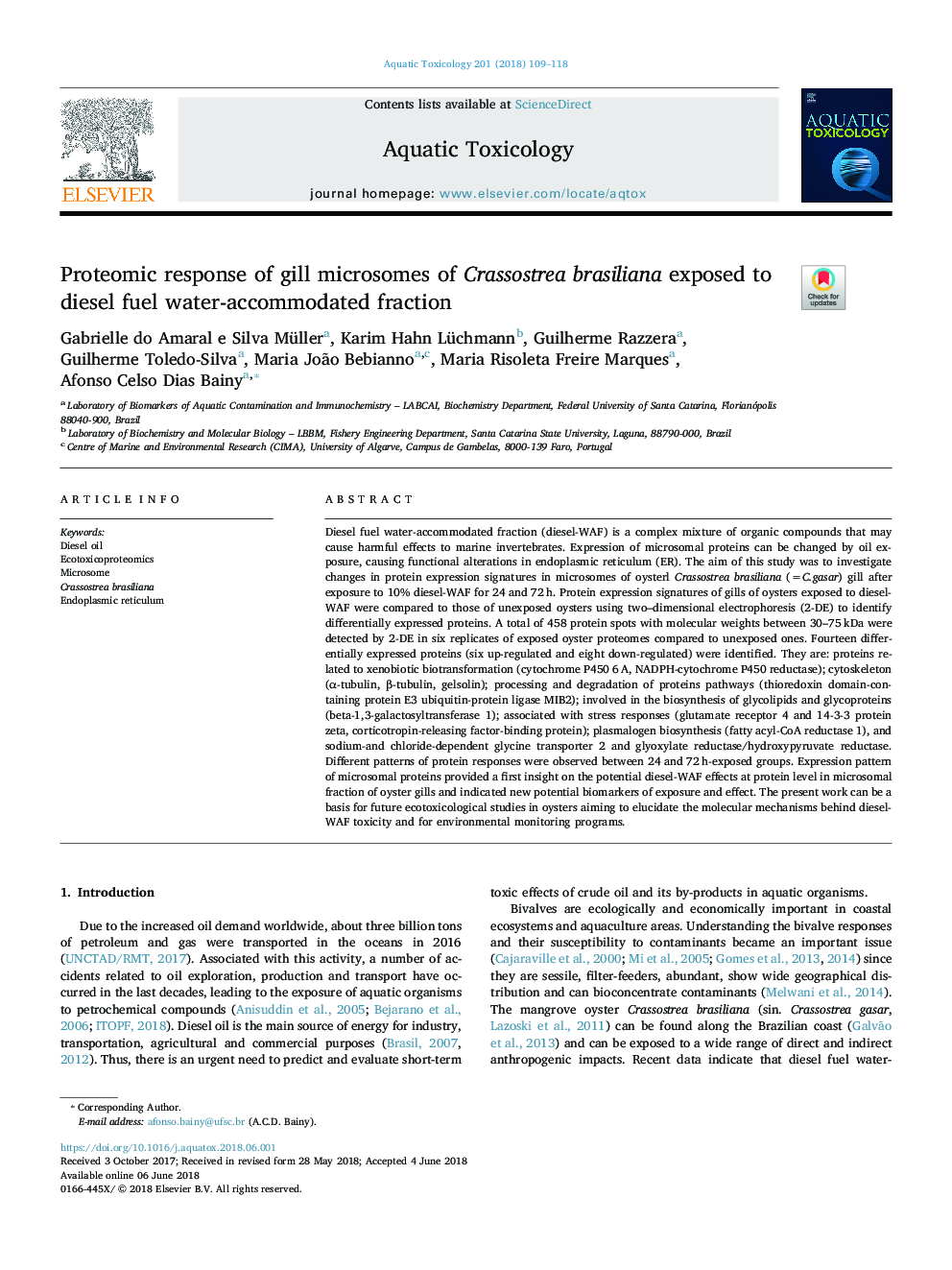| کد مقاله | کد نشریه | سال انتشار | مقاله انگلیسی | نسخه تمام متن |
|---|---|---|---|---|
| 8883676 | 1625904 | 2018 | 10 صفحه PDF | دانلود رایگان |
عنوان انگلیسی مقاله ISI
Proteomic response of gill microsomes of Crassostrea brasiliana exposed to diesel fuel water-accommodated fraction
دانلود مقاله + سفارش ترجمه
دانلود مقاله ISI انگلیسی
رایگان برای ایرانیان
کلمات کلیدی
موضوعات مرتبط
علوم زیستی و بیوفناوری
علوم کشاورزی و بیولوژیک
علوم آبزیان
پیش نمایش صفحه اول مقاله

چکیده انگلیسی
Diesel fuel water-accommodated fraction (diesel-WAF) is a complex mixture of organic compounds that may cause harmful effects to marine invertebrates. Expression of microsomal proteins can be changed by oil exposure, causing functional alterations in endoplasmic reticulum (ER). The aim of this study was to investigate changes in protein expression signatures in microsomes of oysterl Crassostrea brasiliana (=C.gasar) gill after exposure to 10% diesel-WAF for 24 and 72â¯h. Protein expression signatures of gills of oysters exposed to diesel-WAF were compared to those of unexposed oysters using two-dimensional electrophoresis (2-DE) to identify differentially expressed proteins. A total of 458 protein spots with molecular weights between 30-75â¯kDa were detected by 2-DE in six replicates of exposed oyster proteomes compared to unexposed ones. Fourteen differentially expressed proteins (six up-regulated and eight down-regulated) were identified. They are: proteins related to xenobiotic biotransformation (cytochrome P450 6â¯A, NADPH-cytochrome P450 reductase); cytoskeleton (α-tubulin, β-tubulin, gelsolin); processing and degradation of proteins pathways (thioredoxin domain-containing protein E3 ubiquitin-protein ligase MIB2); involved in the biosynthesis of glycolipids and glycoproteins (beta-1,3-galactosyltransferase 1); associated with stress responses (glutamate receptor 4 and 14-3-3 protein zeta, corticotropin-releasing factor-binding protein); plasmalogen biosynthesis (fatty acyl-CoA reductase 1), and sodium-and chloride-dependent glycine transporter 2 and glyoxylate reductase/hydroxypyruvate reductase. Different patterns of protein responses were observed between 24 and 72â¯h-exposed groups. Expression pattern of microsomal proteins provided a first insight on the potential diesel-WAF effects at protein level in microsomal fraction of oyster gills and indicated new potential biomarkers of exposure and effect. The present work can be a basis for future ecotoxicological studies in oysters aiming to elucidate the molecular mechanisms behind diesel-WAF toxicity and for environmental monitoring programs.
ناشر
Database: Elsevier - ScienceDirect (ساینس دایرکت)
Journal: Aquatic Toxicology - Volume 201, August 2018, Pages 109-118
Journal: Aquatic Toxicology - Volume 201, August 2018, Pages 109-118
نویسندگان
Gabrielle do Amaral e Silva Müller, Karim Hahn Lüchmann, Guilherme Razzera, Guilherme Toledo-Silva, Maria João Bebianno, Maria Risoleta Freire Marques, Afonso Celso Dias Bainy,